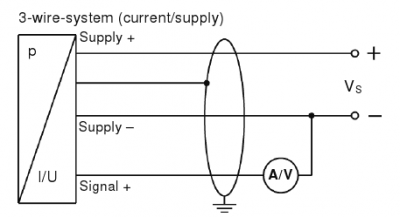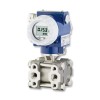3 wire is used to describe a type of electrical connection for a measurement signal which has only three connections for the power supply and signal output, so that the common/negative connection of both are connected and are at the same potential voltage.
A typical example is a 1 to 5 volt output, where there is a separate supply positive, output positive and shared supply/output negative connection.
3 wire is also used to describe a resistive thermometer that is wired so that the error caused by the connecting wire on each side of the resistive thermometer is compensated. Only one side is connected and it is assumed that errors caused by the each wire are the same. therefore this method is less accurate that the 4 wire configuration.
Help
Connecting a 3 wire pressure transmitter
How is a 3 wire 4-20mA pressure transmitter connected electrically?
The 3 wire configuration is similar to the more common 2 wire configuration but the positive voltage supply is separated from the current loop:
Example of Sensor Connections:
- Volts Input + (Supply positive)
- Current Output + (Signal positive)
- Volts Input (negative) / Current Output (Supply negative)

Glossary of Measurement Signal technical terms
- 2 Wire
- 4 to 20 mA Current Loop Output Signal
- 4 Wire
- Amplified Voltage Output
- BFSG – Bonded Foil Strain Gauge
- Deadband
- FSO – Full Scale Output
- HART®
- mV/V – Millivolts per Volt Output Signal
- NC – Normally Closed
- NO – Normally Open
- Piezoresistive Strain Gauges
- Ratiometric
- Span
- Span Offset
- Span Sensitivity
- Square Root Extraction
- Threshold
- Totalizer
- Transducer
- Transmitter
- TSL – Terminal Straight Line
- TSS – Thermal Span or Sensitivity Shift
- Turndown Ratio
- USB
- Vented Cable
- Wheatstone Bridge Strain Gauge
- Zero Offset
- Zero Tare
Help from Measurement Signal resources
- Supply voltage and load resistance considerations for pressure transmitters
- What can cause random variation in pressure transducer output
- What is the difference between zero offset and zero drift?
- Why use 4-20mA and 3-15 psi rather than 0-20mA & 0-15psi




